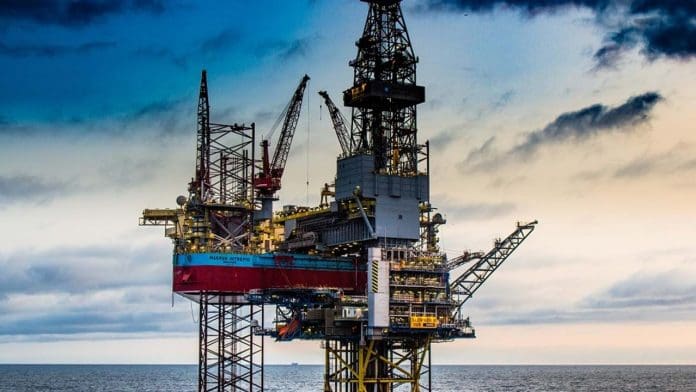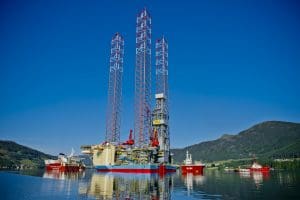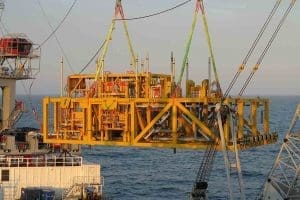
Switzerland-based, Transocean, one of the largest offshore drilling contractors in the world, announced a goal to reduce its operating Scope 1 and Scope 2 greenhouse gas (GHG) emissions intensity by 40% from 2019 levels by 2030. The announcement comes on top of several commitments by other drillers to reduce emissions and engage in more environmentally conscious operations. “Globally, almost one billion people lack access to electricity, and all of us desire reliable and affordable sources of energy that help improve our daily lives,” said Transocean CEO Jeremy Thigpen. “As such, we believe that demand for hydrocarbons and, therefore, for Transocean’s assets and services, will remain strong. Our responsibility extends beyond providing results for our customers. We must continue to deliver our services in a manner that minimizes our impact to the environment and, in this context, supports the interests of all our stakeholders, including employees, customers, investors, and for the broader public good. Currently, nearly all energy used to power Transocean’s global fleet of high-capability drilling rigs is generated through the conversion of diesel fuel to electricity. Therefore, we commit to reduce emissions across our fleet through fuel reductions and other initiatives that can be achieved by developing and implementing new processes and technologies that enable us to optimize our power management capabilities.”
Maersk Drilling Sets The Tone
It’s hard to pinpoint which drilling company was the first to outlay detailed GHG emissions reduction goals, but Maersk Drilling was undoubtedly responsible for setting the bar. In September 2020, Maersk Drilling pledged to reduce carbon dioxide (CO2) emissions by 50% by 2030. Unlike in years past, the company didn’t shy away from directly addressing climate change and specifically called out the issue’s relevance in the decades to come. “Climate change is one of the greatest challenges facing our society today, and we want to do our part in addressing this,” said Maersk Drilling CEO Jørn Madsen. “The global demand for energy is rising and the expert consensus is that renewable energy will not be able to replace all traditional energy production within the foreseeable future. Therefore, the answer must be to provide affordable energy, including oil and gas, while keeping CO2 emissions under control. Our contribution to a sustainable energy future is to significantly reduce emissions from our operations and to explore ways to store CO2.”
Maersk Drilling plans to incorporate a number of solutions that will reduce its emissions. The company will debut the first-ever drilling rig that can operate through onshore power. It’s also converting some of its jack-up rigs to hybrid, low-emission rigs.

In November 2020, Maersk Drilling launched the first ever low-emission rig. “We’re thrilled to now see the full complement of low-emission technology in use on Maersk Intrepid drilling rig, and to receive a very promising first dataset on emissions reductions,” said Caroline Alting, head of integrity and projects at Maersk Drilling. “It’s still too early to make any definitive conclusions on average emissions reductions over time, but the preliminary results are very promising with reductions around 25% compared to the rig’s baseline, driven by both energy-saving technology and behavioral changes supported by the low-emission package. We want to do our part in the transition toward a sustainable energy future.”

The company estimates that around half of its 2030 emissions goal will stem from improving its existing operations, increasing efficiency, etc. The other half will come from completely new endeavors. One such project is Maersk’s partnership with INEOS on Project Greensand, a carbon, capture, and storage (CCS) project aimed at collecting and storing CO2 in depleted oil and gas reservoirs in the Danish section of the North Sea. “Sustainability is an area of concern, also for our customers, and by being a leader in low-emission offshore drilling, we maintain a differentiated offering which can help customers in reaching their targets,” said Madsen. “Investing in climate action is a key focus area for us and we are committed to being at the forefront, leveraging our vast experience with operating in Norway, where sustainability requirements are very high.”
Maersk Drilling will monitor its progress toward its 2030 goal by tracking the output of its CO2 emissions relative to contracted days, distance drilled, and revenue based on a 2019 baseline.
NOV Targets New Technologies To Hit Its Short-Term Goals
National Oilwell Varco (NOV) is taking more of a short-term approach to cutting its emissions. The company isn’t publishing an annual ESG report, but its 2019 comprehensive report set several goals that the company is progressing on nicely. By 2023, NOV believes it can reduce its energy consumption by between 5% and 10% from its 2018 baseline value. In 2018, NOV calculated it had a total energy and natural gas consumption of 1.99 million MWH consisting of 1.11 tons (1.01 million tonnes) of CO2 equivalent from Scope 1 emissions and 0.35 tons (0.32 million tonnes) of CO2 equivalent from Scope 2 emissions.
Similar to Maersk Drilling, NOV’s emissions reductions will largely come from a shift in business segments. The company is growing its integrated solutions for offshore wind installation, solar pumping systems, geothermal drilling tools and equipment, energy storage, and biogas generation solutions.
As of 2019, NOV estimates that around 16.3 MW of capacity, or 75% of European offshore wind turbines, were installed using vessels designed by NOV. The company’s solar pumping systems take water from natural sources such as boreholes, wells, lakes, and rivers and use solar energy to pump that water to agricultural, livestock, industrial, and domestic water supplies. The solution’s ideal use case is in remote and rural communicates where electric or diesel power is unavailable or unreliable.
NOV manufactures drilling tolls and equipment such as drill bits that are specifically designed to drill geothermal wells and its TK glass-reinformed epoxy liner used to prevent corrosion. On the offshore drilling front, NOV PowerBlade hybrid technology reduces fuel consumption on offshore vessels, cuts power pack maintenance costs, and reduces CO2 by using lithium-ion battery solutions. NOV’s Chopper Hopper grinder pump converts waste particles into what NOV calls a “homogenous pumpable mash” suited for biogas production.
All told, NOV’s suite of emerging energy sources underpin its belief that natural gas will work with renewable energy to foster a sustainable future. “While renewable sources of energy will certainly grow in the mix of the energy pie at the end of the day, oil and natural gas continue to be the fuels that power the world,” said NOV CEO Clay Williams, during the company’s Q3 2020 earnings call. “Our customers expect us to push the envelope on technical innovation to improve efficiencies and cash flows for their operations. Knowing this, we have sustained our investment in new technology through the downturn. Investment in the development of new products will form the foundation of NOV’s growth going forward. There’s going to have to be more pull by the oil companies on this technology. And that’s going to be sort of the catalyst, I think, that makes it happen. I think if the exploration and production companies continue to move up the curve on being more demanding around reducing their ESG impact to their frack operations that can accelerate the adoption of the technology.”
Schlumberger Pledges Net-Zero By 2050
In June 2021, Schlumberger announced that it had completed an 18-month project to roll out its decarbonization plan. The result of the study concludes that Schlumberger can become net-zero by 2050. The company also released several interim goals, including a 30% reduction in Scope 1 and Scope 2 emissions by 2025 and a 50% reduction in Scope 1 and Scope 2 emissions by 2030, as well as a 30% reduction in Scope 3 emissions by 2030.
As one of the largest oilfield services companies, Schlumberger is going to have to completely transform its operations if it wants to hit its carbon cutting goals. The company is introducing its Transition Technologies Portfolio, which is essentially a list of ESG-friendly products and services. Although the portfolio is still in its early stages, notable solutions include drilling-efficiency enablers, cements, frac fluids with a low CO2 footprint, and power management systems that aim to maximize rig generator efficiency. Schlumberger is also working on solutions that electrify and connect oilfield infrastructure, which can cut emissions and help reduce and even eliminate flaring.
A product of its 18 months of research, Schlumberger developed a framework that will quantify its progress and set benchmarks through net-footprint comparisons. “There is a new industry imperative to address climate change while meeting the demand for energy both today and in the long term, sustainably,” said Schlumberger CEO Olivier Le Peuch. “We have a 2050 net-zero carbon emissions ambition which I believe is unique in our industry due to our capabilities as a technology company and our culture grounded in science. This reinforces our commitment to unlocking access to energy, for the benefit of all. Our net-zero target is inclusive of total Scope 3 emissions; this is a first in the energy services industry.

“Our decarbonization plans are based upon climate science and focused on three key areas: operational emissions, customer emissions, and carbon-negative actions,” said Katharina Beumelburg, chief strategy and sustainability officer at Schlumberger. “75% of Schlumberger’s baseline GHG footprint comes from the technologies our customers use. To address this, Schlumberger has introduced our Transition Technologies portfolio, which is designed to help customers reduce their Scope 1 and 2 emissions, while simultaneously enabling us to meet our Scope 3 emissions target.”
According to Schlumberger, the company’s decarbonization plan is aligned with the Paris Agreement to limit global warming to 2.7°F (1.5°C) and reach carbon neutrality by 2050. As of June 2021, Schlumberger reported that it is ahead of schedule to achieve its previously set near-term emissions reductions target of 30% by 2025 for Scope 1 and 2.
A Favorable Trend
There’s no denying that 2020 will be remembered as the year of the COVID-19 pandemic, but it was also a pivotal year in the energy industry. In many ways, 2020 marked the beginning of a widespread shift by energy companies away from coal and oil toward natural gas, renewables, and solutions that pair with oil to make it less environmentally harmful.
Whether its opportunities in subsea compression, liquefied natural gas, compressed natural gas, or alternative fuels like renewable natural gas and sustainable aviation fuel, the decision to diversify toward natural gas investments opens up a lot of opportunities previously unavailable in the compression industry. Now that drilling companies are openly discussing carbon neutrality, capital expenditures that would otherwise be used on coal and oil can go toward higher natural gas investment and new technologies that improve the environmental effectiveness of existing operations.
















